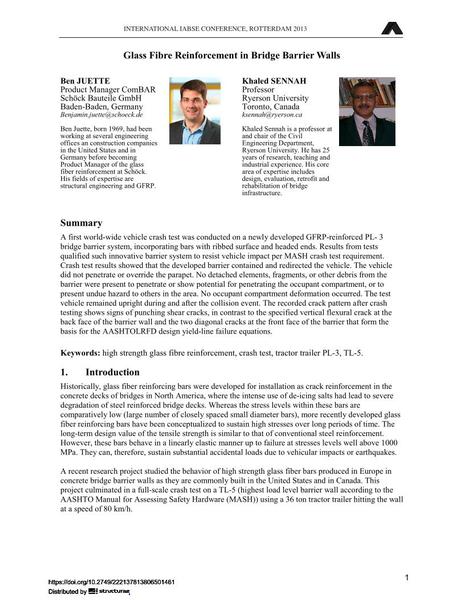Glass Fibre Reinforcement in Bridge Barrier Walls

|
|
|||||||||||
Bibliografische Angaben
| Autor(en): |
Ben Juette
Khaled Sennah |
||||
|---|---|---|---|---|---|
| Medium: | Tagungsbeitrag | ||||
| Sprache(n): | Englisch | ||||
| Tagung: | IABSE Conference: Assessment, Upgrading and Refurbishment of Infrastructures, Rotterdam, The Netherlands, 6-8 May 2013 | ||||
| Veröffentlicht in: | IABSE Conference, Rotterdam, May 2013 | ||||
|
|||||
| Seite(n): | 316-317 | ||||
| Anzahl der Seiten (im PDF): | 8 | ||||
| Jahr: | 2013 | ||||
| DOI: | 10.2749/222137813806501461 | ||||
| Abstrakt: |
A first world-wide vehicle crash test was conducted on a newly developed GFRP-reinforced PL- 3 bridge barrier system, incorporating bars with ribbed surface and headed ends. Results from tests qualified such innovative barrier system to resist vehicle impact per MASH crash test requirement. Crash test results showed that the developed barrier contained and redirected the vehicle. The vehicle did not penetrate or override the parapet. No detached elements, fragments, or other debris from the barrier were present to penetrate or show potential for penetrating the occupant compartment, or to present undue hazard to others in the area. No occupant compartment deformation occurred. The test vehicle remained upright during and after the collision event. The recorded crack pattern after crash testing shows signs of punching shear cracks, in contrast to the specified vertical flexural crack at the back face of the barrier wall and the two diagonal cracks at the front face of the barrier that form the basis for the AASHTOLRFD design yield-line failure equations. |
||||
